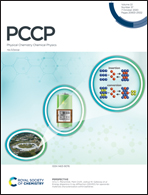Formation of n → π+ interaction facilitating dissociative electron transfer in isolated tyrosine-containing molecular peptide radical cations†
Abstract
Long-range electron transfer in proteins can be rationalized as a sequential short-distance electron-hopping processes via amino acid residues having low ionization energy as relay stations. Tyrosine residues can serve as such redox-active intermediates through one-electron oxidation to form a π-radical cation at its phenol side chain. An electron transfer from a vicinal functional group to this π-electron hole completes an elementary step of charge migration. However, transient oxidized/reduced intermediates formed at those relay stations during electron transfer processes have not been observed. In this study, formation of analog reactive intermediates via electron donor–acceptor coupling is observed by using IRMPD action spectroscopy. An elementary charge migration at the molecular level in model tyrosine-containing peptide radical cations [M]˙+ in the gas phase is revealed with its unusual Cα–Cβ bond cleavage at the side chain of the N-terminal residue. This reaction is induced by the radical character of the N-terminal amino group (–NH2˙+) resulting from an n → π+ interaction between the nonbonding electron pair of NH2 (n) and the π-electron hole at the Tyr side chain (π+). The formation of –NH2˙+ is supported by the IRMPD spectrum showing a characteristic NH2 scissor vibration coupled with Tyr side-chain stretches at 1577 cm−1. This n → π+ interaction facilitates a dissociative electron transfer with NH2 as the relay station. The occurrence of this side-chain cleavage may be an indicator of the formation of reactive conformers featuring the n → π+ interaction.



 Please wait while we load your content...
Please wait while we load your content...